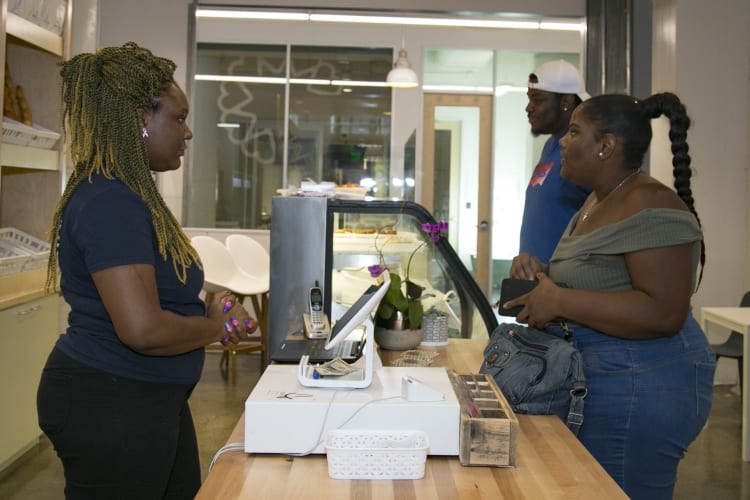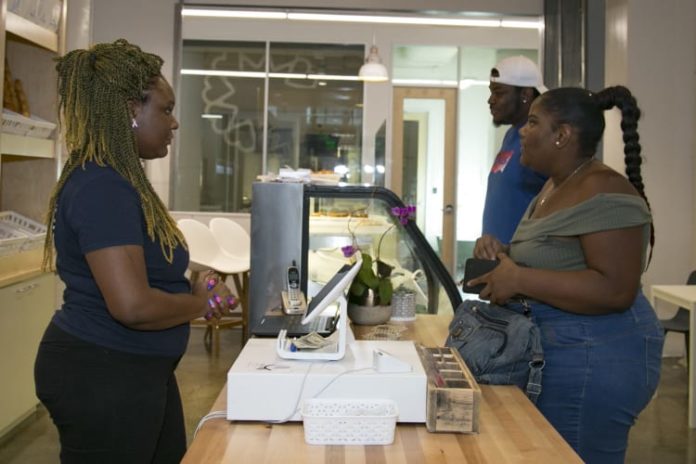by Paul Dudenhefer, High Ground News
First on the list? Six Flags in St. Louis.
That’s where Daria Meeks hopes to take her three children on a trip next year—a prospect that would have been financially impossible several months ago, when Meeks was working at Krystal and earning $7.95 an hour.
Today, Meeks, who is 27, earns a living wage working full-time at Lucy J’s, a nonprofit bakery that opened a store last month in Crosstown Concourse.
Lucy J’s, whose mission is to provide job training and employment for parents who are working to transition out of homelessness, pays its employees $15 an hour, or more than twice the federal minimum. The bakery also provides health insurance through Church Health, a Memphis faith-based nonprofit.
Lucy J’s, which has six full-time employees, began with startup capital from an anonymous donor. The bakery plans to become self-sustaining through bakery sales alone but, if needed, will seek donations or grants to continue to help fund operations.
For years, Meeks, who was first interviewed by High Ground News a year ago, struggled to meet her expenses on a fast food income.
“Rent, groceries, utilities — I couldn’t pay the bills making $7.95 an hour,” she said.
Meeks used to bring home around $400 every two weeks and receive child care assistance from the Tennessee Department of Human Services. In December 2014, the financial burden simply became too great. That month, she and her family moved into the Dorothy Day House, a nonprofit that provides housing and counseling for families in crisis.
 Daria Meeks, 27, takes care of customers at Lucy J’s Bakery. (Natalie Eddings)
Daria Meeks, 27, takes care of customers at Lucy J’s Bakery. (Natalie Eddings)
That’s where Meeks met Tracy Burgess and began a journey that has led to greater self-sufficiency and her current job at Lucy J’s, where she’s been employed since February 2018.
At the time, Burgess was (and still is) the director of development and communications for the Dorothy Day House. With her husband Josh, she was making plans to open a new bakery in Memphis where half of the staff would be current or former clients of the Dorothy Day House.
Today, Meeks does many jobs for Lucy J’s — running the cash register, taking special orders, prepping cupcakes and cookies to keep the bakery running along and the cases full.
“It takes a full-time position at a living wage to raise a family and become self-sufficient,” Burgess said.
Meeks’s experience as a single parent cobbling together hourly work and public assistance reveals the singular challenges facing workers who try to get by on incomes at or near the poverty line.
She said that the Department of Human Services wants to help — but not really. When Meeks started working at Lucy J’s, she was working only 20 hours a week but was making more than she made full-time at Krystal’s. As her income went up, her child care assistance went down, catching her in an exasperating circle familiar to many of the working poor.
“I was trying to do what’s right and support myself as much as possible,” Meeks said. “But the department—it seems like they want to take away from people who are trying to help themselves and give to those who aren’t.”
It is precisely what Meeks confronted — the means-tested nature of so many public assistance programs — that keeps low earners from climbing out of poverty. Rather than supplementing any government aid a worker receives, earnings often supplant the aid, leaving workers in essentially the same financial position.
Eventually, Meeks was able to work full-time at the bakery and went off child care assistance entirely. She recently met with a budget planner and today carefully manages her finances, saving a little here and there for the trip to Six Flags.
For every Daria Meeks, there are hundreds of area workers juggling monthly bills to keep a roof over their heads and put food on the table at low wages.
Today, much hope is being pinned on movements to raise the minimum wage, which since 2009 has been $7.25 an hour, to $15 an hour. Yet raising the minimum is not without potential drawbacks.
 Daria Meeks fixes her two-year-old daughter’s hair in the family’s home. (Natalie Eddings)Economic theory predicts that increasing the minimum wage will result in more unemployment or reduced work hours: as the cost of labor rises, employers will buy less of it or look for cheaper or more cost-effective alternatives. Yet real life is never that simple, which is one reason why empirical studies of the matter have been inconclusive.
Daria Meeks fixes her two-year-old daughter’s hair in the family’s home. (Natalie Eddings)Economic theory predicts that increasing the minimum wage will result in more unemployment or reduced work hours: as the cost of labor rises, employers will buy less of it or look for cheaper or more cost-effective alternatives. Yet real life is never that simple, which is one reason why empirical studies of the matter have been inconclusive.
Jamin Speer, an assistant professor of economics at the University of Memphis, says that empirical studies have shown that small increases in the minimum — say, 50 cents or $1 — have, generally speaking, little effect on employment. But when it comes to much larger increases, such as raising the minimum from its current level to $15, Dr. Speer says that “we just don’t know. Caution is really the word.”
Although numerous cities and states have higher minimums than the federal one, only a handful have raised or plan to raise their minimum wage to $15 an hour. One is Seattle, which in 2014 decided to raise its minimum in a series of steps to $15 as of this year. Two recent studies reported the effects of the first stages of the increase, which bumped the minimum for large employers from $11 to $13. They reached different conclusions, with one study finding “at most a small reduction in employment” and the other “a far more negative effect on employment.”
There are of course non-economic dimensions of the issue as well. The national organization Fight for $15 says that it is simply wrong for companies to make billion-dollar profits and pay their employees so little — an argument that is especially compelling given that the minimum wage, had it kept pace with the economic gains the country has seen since the late 1960s, would be about $19.00 an hour today.
Regardless of any impact a higher minimum might have on employment, there is now a 2013 Tennessee law that makes it harder for municipalities to enact wages in excess of the federal minimum.
The law, often said to ban cities from implementing a living wage, actually only limits a city’s ability to require a higher minimum. The law states that a city cannot require an employer to pay more than the federal or state minimum “as a condition of doing business within the jurisdictional boundaries of the local government or contracting with the local government.”
That means that a city can still provide other incentives for employers to pay more than the minimum by, for instance, charging them higher licensing fees or taxing them at higher rates if they do not pay the higher minimum, points out Daniel A. Horwitz, a Nashville attorney who blogs about the Tennessee Supreme Court.
“Any city in Tennessee can mandate a local minimum wage increase tomorrow without fear,” Horwitz writes in a post from February 2016.
In 2017, Democratic Representative G. A. Hardaway of Memphis proposed a bill that would establish a state minimum wage of $15 an hour. The bill is currently sitting in the House Consumer and Human Resources Committee.
As long as the current minimum is in place, the local economy will have to rely on business owners like Burgess who are committed to paying what they see as fair compensation.
“We want to be an advocate for $15 in this city,” Burgess said.
When asked what she would say to legislators who voted for the 2013 law, Meeks said that lawmakers fail to appreciate the incentives that higher wages create. A living wage, she said, pushes people to work and encourages them to stay employed. “You work 40, 50 hours a week at the minimum wage, and then come home with a check that’s barely $400. It doesn’t seem worth it. Fifteen dollars an hour changes that. It makes you want to work.”
A living wage, Meeks said, “stops the struggle. You can still make it on the minimum wage, but it’s a struggle. At $15 an hour, you can pay your bills, and then things aren’t so hard.”


